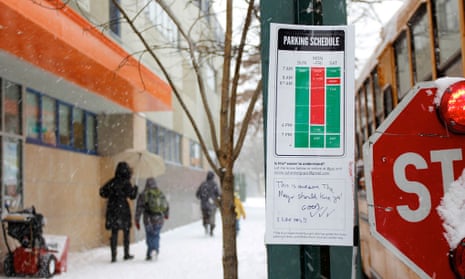This week’s best city stories explore a guerrilla project in New York hoping to make parking easier, creative designs for “surfing” abandoned urban railways and a certain Italian dictator’s secret air-raid shelter in Rome.
We’d love to hear your responses to these stories and any others you’ve read recently, both at Guardian Cities and elsewhere: share your thoughts in the comments below.
To park or not to park?
... that’s the question that confronts many US drivers when the cacophony of complicated and often contradictory parking signs results in total confusion – and often fines. As Pop-Up City explains, designer Nikki Sylianteng decided to take matters in to her own hands and created the To Park or Not to Park initiative.
Using simple red and green graphics, she created signs which instantly communicated where in a certain area you were allowed to park – and at what times. In a somewhat guerrilla move, she then started putting up her signs across New York, directly underneath the official ones. So far the signs seem to have been a hit with the public – but is it drivers’ experiences we should be making easier in cities?
Selling stations
Last month we looked at the disused “ghost” stations of underground transport networks in cities around the world. Now it seems that London’s disused tube stations are being sold off to the highest bidder. As CityMetric reports, these parts of London’s heritage are being snapped up by real estate companies for profitable developments. But what if we gave the stations over to cultural and social use for local communities? “Selling disused tube stations for private real-estate development is a not very creative move in a capital that prides itself of being among the world’s most creative cities,” the author explains.
Rome’s secret bunkers
Looking for something to do this Halloween? Well, if you find yourself in Rome, you could take a tour around Mussolini’s secret underground bunkers. Opening to the public for the first time on October 31 2014, the Italian dictator’s air-raid shelter (which he denied having) can be explored underneath the city’s neoclassical Villa Torlonia. City Lab show us a gallery of photos of the spooky underground hideout.
Painting Chennai
In Chennai, citizens have been busy creating painted murals across the city. As scroll.in reports, walls that have previously been used for ubiquitous advertising have been transformed into canvases for community art and poetry through a project called The Paint Box. “People need to stop for a moment to witness better things on the road and look up from their screens,” the project’s founder said.
Urban railway surfing
French urban design studio HeHe have devised an unusual solution to revitalising abandoned railways – and it’s nothing like the High Line. As Pop-Up City reports, the studio has designed unusual one-person vehicles to transport urban explorers along disused tracks in cities. It might not be a very feasible idea for urban transport, but it sure looks like fun.
Should making parking easier be top of the city transport priority lust? How could disused stations be used to benefit communities? Share your thoughts in the comments below.

Comments (…)
Sign in or create your Guardian account to join the discussion